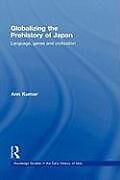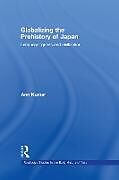Globalizing the Prehistory of Japan
Einband:
Fester Einband
EAN:
9780710313133
Untertitel:
Language, genes and civilisation
Genre:
Politikwissenschaft
Autor:
Ann Kumar
Herausgeber:
Routledge
Auflage:
1. Auflage
Anzahl Seiten:
220
Erscheinungsdatum:
27.10.2008
ISBN:
0710313136
Zusatztext 'This book succeeds in forcing us to reconsider the possible long-distanceinfluences on early Japan as well as overturning the assumption that Java was always acultural recipient! whether of Austronesians or Indianization! and it constitutes a strongcase for more systematic Metal-Age archaeology on Java and its surrounding islands.' - DORIAN Q. FULLER University College London. Informationen zum Autor Ann Kumar is Professor in the Faculty of Asian Studies, Australian National University, and former Vice-President of the Australian Academy of the Humanities. Klappentext This innovative work uses new evidence to challenge previously-held views on the prehistory and origins of Japanese society and identity. The changes in society in Japan between the Jomon and Yayoi cultures were unique, going far beyond those of the so-called Neolithic Revolution in other parts of the world. Uniquely, they included bronze and iron production, as well as a new architecture with symbolic significance, a new religion and a hierarchical society with an emperor at its head. The Yayoi period has been seen as the very beginning of Japanese civilization and identity. It has usually been thought that all the Yayoi innovations came from China and Korea, but this work uses new materials from diverse fields including rice genetics, DNA and historical linguistics to show that the major elements of Yayoi civilization actually came from the south. This is an important contribution to the prehistory of Japan and of South East Asia. Zusammenfassung This iconoclastic work on the prehistory of Japan and of South East Asia challenges entrenched views on the origins of Japanese society and identity. Inhaltsverzeichnis 1. Myths and Mental Space 2. The Prehistories of Japan and Indonesia 3. The Evidence of the Rice 4. The Evidence of the Teeth and Skulls 5. DNA, Ancient and Modern 6. The Evidence of Language: the Words that Tell the Story 7. Royal Rice Rituals and the Cultivated Prince Conclusion ...
Autorentext
Ann Kumar is Professor in the Faculty of Asian Studies, Australian National University, and former Vice-President of the Australian Academy of the Humanities.
Klappentext
This innovative work uses new evidence to challenge previously-held views on the prehistory and origins of Japanese society and identity. The changes in society in Japan between the Jomon and Yayoi cultures were unique, going far beyond those of the so-called Neolithic Revolution in other parts of the world. Uniquely, they included bronze and iron production, as well as a new architecture with symbolic significance, a new religion and a hierarchical society with an emperor at its head. The Yayoi period has been seen as the very beginning of Japanese civilization and identity. It has usually been thought that all the Yayoi innovations came from China and Korea, but this work uses new materials from diverse fields including rice genetics, DNA and historical linguistics to show that the major elements of Yayoi civilization actually came from the south. This is an important contribution to the prehistory of Japan and of South East Asia.
Zusammenfassung
This iconoclastic work on the prehistory of Japan and of South East Asia challenges entrenched views on the origins of Japanese society and identity.
Inhalt
1. Myths and Mental Space 2. The Prehistories of Japan and Indonesia 3. The Evidence of the Rice 4. The Evidence of the Teeth and Skulls 5. DNA, Ancient and Modern 6. The Evidence of Language: the Words that Tell the Story 7. Royal Rice Rituals and the Cultivated Prince Conclusion

Leider konnten wir für diesen Artikel keine Preise ermitteln ...
billigbuch.ch sucht jetzt für Sie die besten Angebote ...
Die aktuellen Verkaufspreise von 6 Onlineshops werden in Realtime abgefragt.
Sie können das gewünschte Produkt anschliessend direkt beim Anbieter Ihrer Wahl bestellen.
Loading...
Die aktuellen Verkaufspreise von 6 Onlineshops werden in Realtime abgefragt.
Sie können das gewünschte Produkt anschliessend direkt beim Anbieter Ihrer Wahl bestellen.
| # | Onlineshop | Preis CHF | Versand CHF | Total CHF | ||
|---|---|---|---|---|---|---|
| 1 | Seller | 0.00 | 0.00 | 0.00 |
